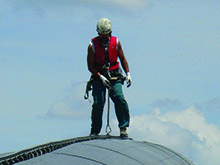Horizontal lifelines are one type of fall protection system that are used in elevated work environments when employees need continuous fall protection throughout an area. When designing a horizontal lifeline system, the number of workers, length of the system, attachment to the existing building or structure and the configuration of the work area are all taken into account. At Atlantic Fall Protection, we create horizontal lifeline systems to fit our client’s specific needs. Horizontal lifelines are a viable fall protection option when designed and engineered by knowledgeable and qualified individuals.
The correct installation of horizontal lifelines is vital to the safety of the personnel utilizing the system. Every Horizontal lifeline system should be installed by factory certified installers. Fall Protection installation is a specific trade and incorrect installation puts employers and employees at risk of injury or death.
OSHA has very specific fall protection standards relating to the design of horizontal lifelines. According to OSHA, horizontal lifeline systems must be designed by a Certified Professional Engineer with extensive knowledge of fall protection. All other OSHA standards must also be considered to ensure the system is compliant. Non-compliant systems are vulnerable to OSHA fines, employee injury, death and litigation.
Some temporary horizontal lifelines are sold as “do-it-yourself” systems. These temporary systems must meet the same design, engineering and installation criteria as permanent horizontal lifelines.






